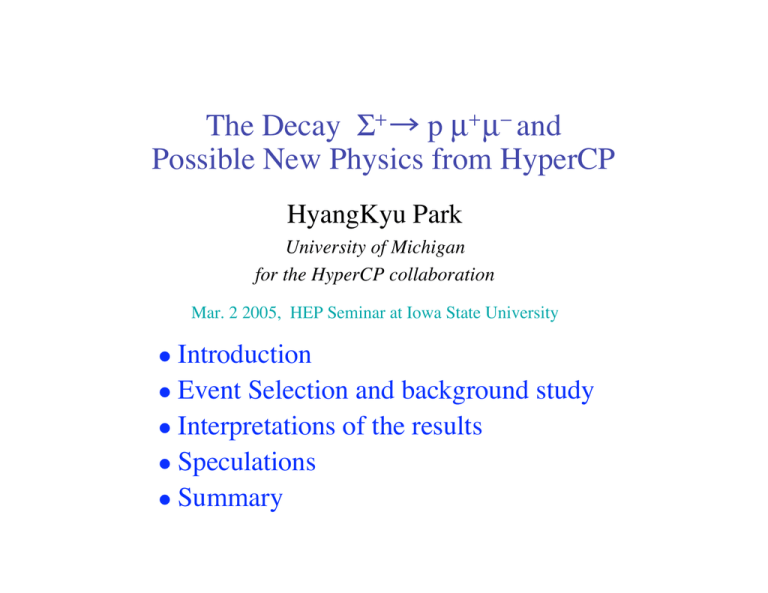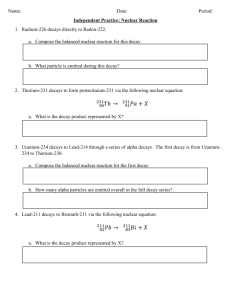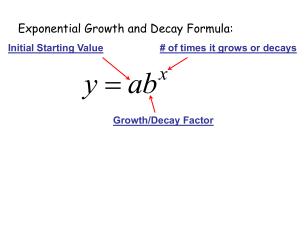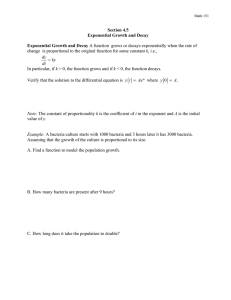Σ → p µ The Decay
advertisement

The Decay Σ+ → p µ+ µ− and Possible New Physics from HyperCP HyangKyu Park University of Michigan for the HyperCP collaboration Mar. 2 2005, HEP Seminar at Iowa State University Introduction Event Selection and background study Interpretations of the results Speculations Summary Introduction and Physics Motivation (I) In SM, the decay Σ+ → FCNC p l+l- (l=e µ) is described by these diagrams: Internal conversion Search for a new light scalar or vector particle: FCNC at tree level Extensions of SM usually predict a new scalar or vector particle. Generally mass range for a new particle is model-dependent. Note: This diagram would be distinguished by the dilepton mass distribution and branching ratio. Introduction and Physics Motivation (II) Main uncertainty for the dilepton distribution and decay rate for the decay Σ+ → p l+l- is the hadronic matrix element, Use Σ+ → pγ decay to reduce the theoretical uncertainty. The hadronic matrix element has 4 form factors: b1, b2, c1 and c2 Form factors, b1 and b2, can be extracted from the decay rate and parameter for Σ+ → pγ : The limits on the form factor c1 and c2 are determined from the upper limit for Σ+ → p e+ e− . Introduction and Physics Motivation (III) Dilepton distribution Σ+ → p e+ e− Σ+ → p µ+ µ− Theoretical prediction (L. Bergström, R. Safadi and P. Singer, Z. Phys. C 37, 281 (1988)) (back-of-envelop estimation) Violation of these limits signal of new physics or Experimental result: Modification of form factors. HyperCP Collaboration Production of Secondary Beams P (800 GeV/c) + Cu → Secondary Particles Collimator (6.1 m) with 1.7 T of Dipole Magnetic Field – Bend charged particles upward or downward → Select either + or - particles – Central-Orbit Momentum: 170 GeV/c Only long-lived charged particles exit from the Collimator: Mainly HyperCP Spectrometer 13 m vacuum decay region 9 fast narrow-pitch MWPC (36 planes) Analysis Magnet: Bend charged particles in horizontal direction Simple trigger using hodoscopes Left-Right trigger: Coincidence of the left- and right-side hodoscope hits Muon System: Only particle ID detector – Stations on left and right side – Total 3.2 (2.3) m-thick steel absorber in left (right) side – In each station: 3 layers of proportional tubes 2 hodoscope planes for trigger – Accepted muon momentum: > 20 GeV/c HyperCP Spectrometer Proton on target ≈ 7 GHz Secondary beam rate ≈ 13 MHz The typical run cycle: + + + - + + + - Summary of the 1997 and 1999 runs 1997 run 1999 run Total Number of tapes 8,980 20,421 29,401 Data Volume 38 TB 82 TB 120 TB Number of reconstructed events Beam Polarity Decay Negative Positive Ξ → Λπ 2 x 109 0.5 x 109 K → 3π 0.16 x 109 0.39 x 109 15 x 106 5.0 x 106 Ω → ΛK Σ+ yield is ~10 times Ξ-. Expect ~1010 Σ+ decays. Mass Plots from Total Sample Data Analysis Strategy for Σ+ → pµ+µ− (Ι) Use the positive and negative data set from ‘99 run. Split two exclusive samples: Dimuon and Signle-muon sample Muon selection: – Hits in 2 out of 3 proportional tubes in both x and y view. – Hits in both vertical and horizontal hodoscopes in the muon station Proton candidate selection: 1. Any hadron track in left side 2. For an event with more than one hadron track: One-vertex constrained χ2 fit with two unlike-sign muon tracks Select the proton candidate having lower χ2/ndf Dimuon sample for the signal search: – Two unlike-sign muons and proton candidate – Unlike-sign dimuon trigger prescaled by 1. Data Analysis Strategy for Σ+ → pµ+µ− (ΙΙ) Single-muon sample for background study: – Only one track is tagged by the muon selection – Non-muon track: Opposite-sign of the muon track. Within the fiducial volume of muon station. – Prescale factors for the single muon trigger: 5 and 10 for the right- and left-side muon station, respectively. Do not expect the signal from the single muon sample. Use the basic selection and additional selection cuts Reconstruct mass with p µ+ µ- hypothesis Basic Selection Cuts I (z-vertex) Decay vertex within the vacuum decay pipe: z-vertex (Reconstruct z-vertex by the distance of closest approach.) Dimuon Sample Collimator exit Vacuum window & C1 Z=100 cm Z=1300 cm Basic Selection Cuts II (single-vertex tagging) Decay consistent with single vertex: 1) Good fit: χ2/ndf 2) Lateral separation at z-vertex: DCA=(d1+d2+d3)/3 MC: Σ+ → p µ+ µ− Basic Selection Cuts III (Target Pointing and Total Momentum) The Σ+ beam from the target: MC: Σ+ → p µ+ µ− target pointing cut Momentum acceptance of the collimator: total momentum of 3 tracks Data: Ξ→Λπ Additional Selection Cut Hadron momentum fraction cut: MC: MC: MC: MC: Σ+→p µ+ µK+→ 3 π K+→ π+ π- µ+ υ K+→ π+ µ+ µ- Require fhad > 0.68 – Preserve 100% of the signal – Strong rejection of K+ backgrounds cut fhad Event Selection for Σ+ → pµ+µ- (Data) Basic selection cut Basic selection and fhad cuts Total 7 events (3+4) Observed 3 candidates within 1 σ of mass resolution (1 ΜeV/c2 ): only in positive-beam dimuon data. Background events were more than 20 σ from Σ+ mass. Background Study: Hyperon decays Ordinary hyperon decays contribute to like-sign dimuon events, e.g., pion or kaon decay from µ+ p µ- Hyperon decays are not background Background Study: K+ decays (I) 1.0 x 1010 K+ decays in positive-beam data Backgrounds from K+ decays: K+ → π+ π+ π− , K+ → π+ π− µ+ ν K+ → π+ µ+ µ− , K+ → µ+ µ− µ+ ν Not observed In MC study, none of them are serious sources: Used 40 to 100 times more MC events than the number of expected backgrounds Non-gaussian tails of K+ decays, unknown and accidental background: Check with real data Data MC: Σ+ → pµ+µ- Background Study: K+ Decays (II) (single muon) Basic Selection Cut Data: (Red) MC: Σ+→ p µ+µ- (Black) (dimuon) Data: (Red) MC: Σ+→ p µ+µ- (Black) Use the single-muon sample: 30 times larger than the dimuon sample In the exclusive single-muon sample: more background, no events below 1200 MeV/c2 Background Study: K+ Decays (II) (single muon) Basic Selection Cut Data: (Red) MC: Σ+→ p µ+µ- (Black) (dimuon) Data: (Red) MC: Σ+→ p µ+µ- (Black) Use the single-muon sample: 30 times larger than the dimuon sample In the exclusive single-muon sample: more background, no events below 1200 MeV/c2 Background Study: Photon Conversion (III) The probability for γ conversion to µ+µ− at the window of the decay pipe: ~10-7 Photon sources from known decays: MC: Σ+ → p π0, π0 → γ γ Red: After cut K+ → π+ π0 , K+ → π+ γ γ Σ+ → p π0 , Σ+ → p γ Dimuon Trigger acceptance for photon conversions: ~10-2 to 10-4 (~10-3 for signal) Used 100~1000 times more MC events than the expected background level Checked proton momentum at the rest frame of Σ+ for 3 candidate events MC: Σ+ → p γ, γ → µ+µ− Red: Data Background Study: Dimuon Sample (IV) Relaxed all basic selection cut values by 1σ of each cut resolution for the dimuon sample for positive beam: Increased background level but still no events within 8 σ. Background Study: Dimuon Sample (V) Negative-beam dimuon data No signal events in dimuon sample for negative beam: production is suppressed by ~10 for negative beam. The dimuon sample with negative beam is 50% of positive beam. Based on the background study, the candidates are unlikely due to background. Measuring B(Σ+ → pµ+µ-) Use Σ+ → p π0 , π0 → e+ e- γ decays for normalization. (No gamma detector in HypreCP) Measure B(Σ+ → pµ+µ-) according to the equation: 100 = Prescale factor for normalization Nobs = Number of observed events A = Geometric acceptance = Event selection efficiency = Efficiency of identifying µ+ µ- (96.2%) = Relative trigger efficiency (91.9%) Signal mode: unlike-sign dimuon trigger Normalization mode: Left-Right trigger Number of Σ+ → p π0 , π0 → e+ e- γ Decays Apply the basic selection and fhad cuts to the data sample from the Left-Right trigger. (The cut values were optimized for the selection of Σ+ → p π0 , π0 → e+ e- γ ) MC (signal+background) Data Compared Mpee distribution for the data with MC signal and background events: Nnorm=(189.7 ± 27.4) No. of Σ+ decays in ‘99 positive data: (2.14 ±0.31) x 1010 Interpretations of Results: Σ+ → pµ+µ- (I) Use two decay models for Σ+ → pµ+µ-: form factor uniform decay If 3 candidates are Σ+ → pµ+µ- decays, (uniform decay) (form factor) If they are background, (uniform decay), @ 90% C.L. (form factor), @ 90% C.L. Interpretations of Results: Σ+ → pµ+µ- (II) In this measurement, we assume that the form-factor model is correct. – Choose the form factors to make B(Σ+ → p e+ e-) as small as possible. B(Σ+ → p e+ e-)=8.9x10-6. (form-factor model) (HyperCP) If B(Σ+ → p e+ e-) < 7x10-6 in PDG is correct, we would expect Β(Σ+ → pµ+µ-) ~ 10-9. The R-value would give an idea to check the form-factor model. Search for Σ+ → p e+ e- Decays Σ+ → p γ, γ → e+ e- Observed the peak at Σ+ with the hypothesis, Σ+ → p e+ e- decays. In very preliminary study with the prescaled data set and MC study of Σ+ → p γ, γ → e+ e-, the observed peak is consistent with Σ+ → p e+ e- decays. Interpretations of Results: Σ+ → pX0, X0 → µ+µ− Dimuon masses for 3 candidates are clustered within ~ 1 MeV/c2. Data MC: Σ+ → pµ+µ- Σ +→ p X0,X0 → µ+µ- (MC) Data Probability for dimuon masses of 3 events to be within 1 MeV for Σ+ → pµ+µ- decays in SM (form factor) is 0.8%. Suggests two-body decays, Σ+ → pX0, X0 → µ+µ− : Systematics for Each Scenario Main source of systematic error: modeling of Σ+ momentum spectrum. Total systematic error is comparable to the statistical error. Speculations for Σ+ → pX0, X0 → µ+µ− Scenario Before taking the Σ+ → pX0, X0 → µ+µ− seriously, we have to consider the following questions: – Is the X0 a hadron ? – Is the X0 a scalar (pseudoscalar) or a vector (axial vector) particle ? – Is there a theoretical model that suggests an X0 (214.3 MeV/c2) ? – Why previous experiments have not seen the X0 ? – Other possible decay modes ? In this discussion, we assume that the X0 is short-lived (cτ < ~mm), and is produced by this diagram: µ+ µ− Is the X0 a hadron ? The X0 can not be a hadron. For two-body decays, the partial decay rate is given by M p1, m1 p2, m2 matrix element Suppose that the matrix element for Σ+ → p π0 is similar to Σ+ → pX0. Note that Previous experiments should have observed the X0 if it were a hadron. Is the X0 a scalar or a vector particle ? Either a scalar or a vector particle is possible at current level of statistics. If the X0 is a vector particle, we expect If the X0 is a scalar particle, X0→ e+e- is a helicity suppressed mode. Check the dieletron masses for the observed Σ+ → pe+e- decays. Data prescaled by 100 0.2 e+e- events X0 0 e+e- events Is there a theoretical model that suggests an X0 (214.3 MeV/c2) ? (I) In SUSY, spontaneous SUSY breaking generates Goldstone fermion (Goldstino), which gives the longitudinal component of gravitino. There should exist superpartners of Goldstino: sgoldstinos, pseudoscalar P0 and scalar S0 The masses of P0 and S0 are generally arbitrary. Perhaps < a few GeV or a few MeV P0 and S0 can couple with SM particles, quarks, leptons and gauge bosons. Interactions of sgoldstinos P0 and S0 with quarks are given by Neutral current FCNC at tree level Is there a theoretical model that suggests an X0 (214.3 MeV/c2) ? (II) The observed events are a possible candidate for sgoldstino in SUSY. If the masses of P0 and S0 are less than two pion masses, they can decay into photon or lepton pairs (D.S. Gorbunov, Nucl. Phys. B602 (2001) 213). F : SUSY breaking scale, Mγγ : order of photino mass (~100 GeV) Al : soft mass term (~100 GeV) short lived one (=consistent with single vertex for the observed events) Why previous experiments have not seen X0 ? (I) Many experiments have searched for a light boson: A short lived X0 of mass 214.3 MeV/c2 has not been well searched for. Why previous experiments have not seen X0 ? (II) Search for the decay K+→π+ X0, X0 →µ+µ- using HyperCP data. K± → π± µ+µ- data No evidence of X0 Note: 1 event sensitivity is an order of 10-10. Larger phase space for K+→π+X0 than for Σ+ → pX0. Either X0 is a vector particle or we need a mechanism for K+ π+ X0. → Why previous experiments have not seen X0 ? (III) The vector particle possibility can be ruled out by KTeV collected 9327 events, No evidence for : Why previous experiments have not seen the X0 ? (IV) There is a possibility for parity-conserving sgoldstino interaction. (D. S. Gorbunov and V. A. Rubakov, PRD 64, 054008 (2001)) “Parity conservation in sgoldstino interactions with quarks and gluons may not be accidental… It is likely that sgoldstino interaction will conserve parity in supersymmetric versions of other models designed to solve the strong CP problem without introducing light axion.” If X0 is a pseudoscalar, this is suppressed (parity violation). If X0 is a pseudoscalar, this is allowed (parity conservation). (hep-ex/0308061) Perhaps the X0 is a candidate for pseudoscalar sgoldstino (P0) with parity conserving interaction. Why previous experiments have not seen X0 ? (IV) Allowed limit for Σ+→pX0 with parity-conserving sgoldstino interaction. (private communication with D. S. Gorbunov) Using ΔmK (KL-KS mass difference) and ε parameter of CP violation, extract the constraints on sgoldstino coupling in s→d quark transition. B(Σ+→pX0) < 10-3 to 10-6 depending on the constraints. Other possible decay modes ? Possible decay modes to search for pseudoscalar X0 (214.3 MeV/c2) with parity-conserving interaction: Note: No measurements for – Decay modes for charm and beauty mesons: more phase space than s-quark sector Other Possible Searches e+ e- → γ X0 e- γ γ X0 e+ σ(e+ e- → γ X0) ~ 0.01 pb to 1 fb @ √s = 10 GeV J/ψ → γ X0 (CLEO-c will collect ≈1 billion of J/ψ γ J/ψ X0 ) γ J/ψ X0 B(J/ψ → γ X0) ~10-8 Summary We observed three candidates with p µ+ µ - mass consistent with Σ+ decays: No background within 20 σ This is the rarest decay ever observed in the baryon sector. (form factor) The dimuon masses for three candidates are clustered within ~ 1 MeV/c2, which could imply Σ+ → pX0, X0 → µ+µ− : The X0 would be a candidate for pseudoscalar sgoldstino with parity-conserving interaction in SUSY. Further work is needed to confirm our result.








